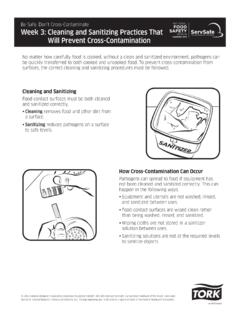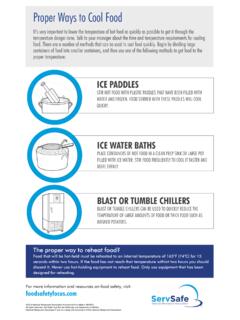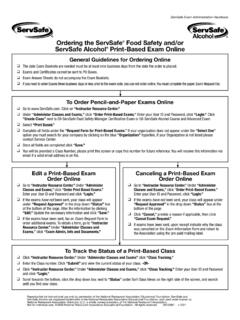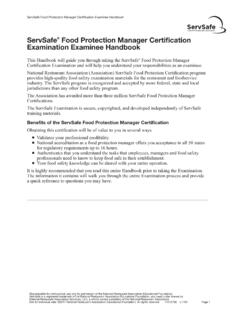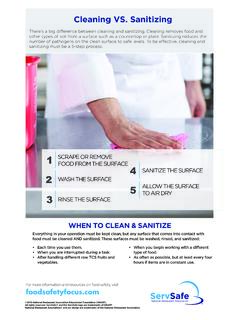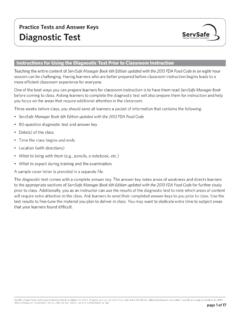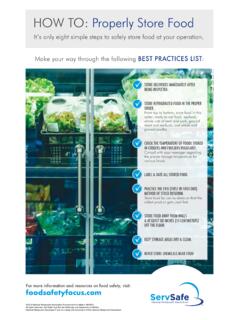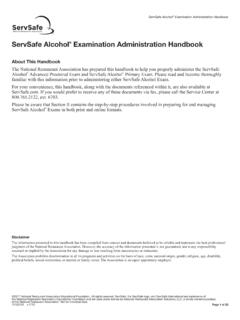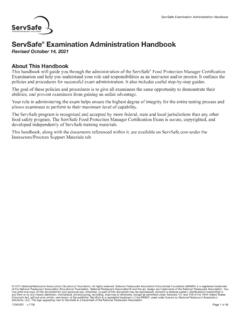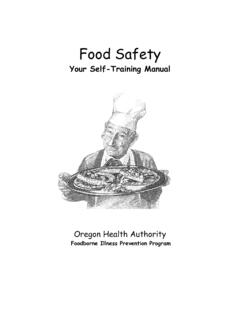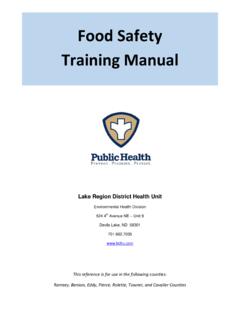Transcription of Practice Tests and Answer Keys Practice Test - ServSafe
1 Page 1 of 6page 1of6 Prcft1iTs6fndfc61 AssrwPf6 Prc1 Kynwf6 Prcft1 Nrncyf6 Prc1moiAKNDW1 Att1dPhu6s1dTsTdvTyW1lTdvlfkTb1Ps1f16dfy T?fdC1rk16uT1oiAKNW1of6 Prcft1iTs6fndfc61 AssrwPf6 Prcb1fcy16uT1fdw1yTsPhc1fdT16dfyT?fdCs1r k16uT1of6 Prcft1iTs6fndfc61 AssrwPf6 PrcW1iTxdrynwPStT1krd1 Pcs6dnw6 Prcft1nsT1rctMW1or61krd1 PcyPvPynft1sftTWPractice Tests and Answer KeysPractice TestName Date 1 Which group of individuals has a higher risk of foodborne illness?A TeenagersB Elderly peopleC WomenD Vegetarians2 Parasites are commonly associated withA ready-to-eat Ciguatera toxin is commonly found inA Which is a TCS food ?A SaltinesB BananasC Baked potatoD Coffee5 Metal shavings are which type of contaminant?A BiologicalB PhysicalC ChemicalD Microbial6 What should foodservice operators do to prevent the spread of hepatitis A?A Cook food to minimum internal temperatures B Freeze fish for 36 hours before servingC Exclude staff with jaundice from the operationD Purchase mushrooms from approved, reputable suppliersPractice Tests and Answer Keys Practice Test 2014 National Restaurant Association Educational Foundation (NRAEF).
2 All rights reserved. ServSafe is a trademark of the NRAEF. National Restaurant Association and the arc design are trademarks of the National Restaurant Association. Reproducible for instructional use only. Not for individual 2 of 67 To wash hands correctly, a food handler must firstA apply wet hands and scrub hands and arms vigorously. D use a single-use paper towel to dry What should foodservice operators do to prevent customer illness from Shigella Freeze food at temperatures below 0 B Exclude food handlers diagnosed with jaundice C Purchase shellfish from approved suppliersD Control flies inside and outside the operation 9 What must a food handler with a hand wound do to safely work with food ?A Bandage the wound with an impermeable cover and wear a single-use gloveB Bandage the wound and avoid contact with food for the rest of the shiftC Wash the wound and wear a single-use gloveD Apply iodine solution and a permeable bandage!0 What item is considered acceptable work attire for a food handler?
3 A False eyelashesB Nail polishC Plain-band ring D Antimicrobial plastic watch band!1 What task requires food handlers to wash their hands before and after doing it?A Taking out garbageB Touching clothing or apronsC Handling raw meat, poultry, or seafood D Using chemicals that might affect food safety!2 Which action requires a food handler to change gloves?A The food handler is working with raw seafood at temperatures above 41 F (5 C)B The food handler is prepping raw chicken on a yellow cutting boardC The food handler has been working with raw ground beef for an hourD The food handler is wearing gloves that have been torn!3 How should the temperature of a shipment of cottage cheese be taken when it arrives at an operation?A Use an air probe to check the temperature of the delivery truckB Hold an infrared thermometer to the outside of the case or cartonC Place the thermometer stem between shipping boxes for a readingD Place the thermometer stem into an opened containerPractice Tests and Answer Keys Practice Test 2014 National Restaurant Association Educational Foundation (NRAEF).
4 All rights reserved. ServSafe is a trademark of the NRAEF. National Restaurant Association and the arc design are trademarks of the National Restaurant Association. Reproducible for instructional use only. Not for individual 3 of 6!4 When should a shipment of fresh chicken be rejected?A The flesh of the chicken appears Shellstock identification tags are not attached to the The flesh of the chicken is firm and springs back when The receiving temperature is 50 F (10 C).!5 Where should ground fish be stored in a cooler? A Above shellfishB Below ground poultryC Above ready-to-eat foodD Below pork roasts!6 What is the maximum number of days that ready-to-eat food prepared on-site can be stored if held at 41 F (5 C)?A 3 daysB 5 daysC 7 days D 10 days!7 In top-to-bottom order, how should a fresh beef roast, fresh halibut, lettuce, and a pan of ground chicken be stored in a cooler?A Lettuce, fresh beef roast, ground chicken, fresh halibutB Lettuce, fresh halibut, fresh beef roast, ground chickenC Fresh halibut, lettuce, ground chicken, fresh beef roastD Fresh halibut, fresh beef roast, ground chicken, lettuce!
5 8 What organization requires Material Safety Data Sheets?A food and Drug AdministrationB Occupational Safety and Health AdministrationC Environmental Protection AgencyD National Restaurant Association !9 What is the minimum internal cooking temperature for green beans that are hot-held for service?A 165 F (74 C)B 155 F (68 C)C 145 F (63 C)D 135 F (57 C)@0 What food item does the food and Drug Administration advise against offering on a children s menu?A Rare cheeseburgersB Egg saladC Peanut butter and jelly sandwichesD Fried shrimpPractice Tests and Answer Keys Practice Test 2014 National Restaurant Association Educational Foundation (NRAEF). All rights reserved. ServSafe is a trademark of the NRAEF. National Restaurant Association and the arc design are trademarks of the National Restaurant Association. Reproducible for instructional use only. Not for individual 4 of 6@1 TCS food reheated for hot-holding must reach what temperature?A 135 (57 C) for 15 secondsB 145 (63 C) for 15 secondsC 155 (68 C) for 15 secondsD 165 (74 C) for 15 seconds @2 What method should never be used to thaw food ?
6 A Place the item in a coolerB Place the item on a prep counterC Microwave the itemD Cook the item@3 When partial cooking food to be finished later, what is the maximum cooking time allowed during initial cooking?A 60 minutesB 45 minutesC 30 minutesD 15 minutes@4 food held at 41 F (5 C) or lower before being removed from refrigeration can be held without temperature control for up to how many hours?A 2B 4C 6D 8@5 Hot TCS food can be held without temperature control for a maximum ofA 2 4 6 8 hours.@6 Which food may be re-served to customers?A Unused, uncovered condimentsB Uneaten breadC Unopened pre-packaged foodD Unused whole fruit garnish@7 What is the purpose of setting critical limits in a HACCP plan?A To identify potential hazardsB To identify where hazards can be eliminatedC To reduce hazards to safe levelsD To determine if the HACCP plan is workingPractice Tests and Answer Keys Practice Test 2014 National Restaurant Association Educational Foundation (NRAEF). All rights reserved.
7 ServSafe is a trademark of the NRAEF. National Restaurant Association and the arc design are trademarks of the National Restaurant Association. Reproducible for instructional use only. Not for individual 5 of 6@8 What is the minimum water temperature required when using hot water to sanitize objects?A 171 F (77 C)B 173 F (78 C)C 176 F (80 C)D 179 F (81 C)@9 What HACCP principle is being practiced when food handlers rewash melons that have surface dirt? A MonitoringB Corrective actionC Critical limitD Critical control point#0 What is the final step in cleaning and sanitizing a prep table? A Sanitizing the surfaceB Allowing the surface to air-dryC Washing the surfaceD Rinsing the surface#1 What is the minimum time an iodine sanitizer solution must be in contact with the object being sanitized?A 15 secondsB 30 seconds C 45 secondsD 60 seconds#2 If a food -contact surface is in constant use, how often should it be cleaned and sanitized? A Every 2 hours B Every 4 hours C Every 6 hoursD Every 8 hours#3 What is the third step in cleaning and sanitizing items in a three-compartment sink?
8 A Sanitizing B Air-drying C Rinsing D Washing#4 What type of thermocouple probe should be used to check the internal temperature of a beef roast?A AirB SurfaceC Immersion D PenetrationPractice Tests and Answer Keys Practice Test 2014 National Restaurant Association Educational Foundation (NRAEF). All rights reserved. ServSafe is a trademark of the NRAEF. National Restaurant Association and the arc design are trademarks of the National Restaurant Association. Reproducible for instructional use only. Not for individual 6 of 6#5 What food safety Practice can prevent cross-contact?A Using only food -grade equipmentB Washing, rinsing, and sanitizing utensils before each useC Keeping food frozen until useD Purchasing food from approved, reputable suppliers#6 What is the most likely cause of wheezing and hives?A food allergiesB NorovirusC Shigella Hepatitis A#7 What is a basic characteristic of a virus? A Destroyed by cookingB Grows in foodC Requires a living host to growD Commonly found in cattle intestines #8 Where should staff members eat, drink, smoke, or chew gum?
9 A Where customers eatB In dishwashing areas C Outside the kitchen doorD In designated areas#9 When can a food handler with a sore throat and a fever return to work with or around food ? A The fever is gone for 24 The sore throat is A written medical release is No symptoms are experienced for 24 hours.$0 What should a foodservice operator do when responding to a foodborne-illness outbreak?A Notify the media B Segregate the product C Close the operation for the dayD Ask customers for proof of their symptoms
